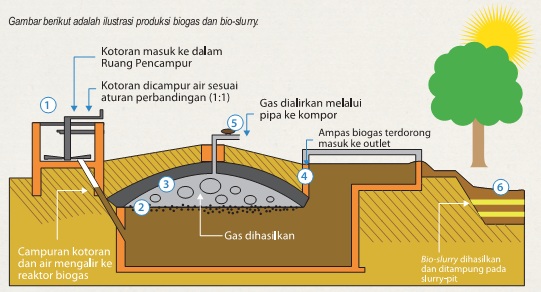Bio-slurry extension
Bio-slurry discharged from the reactor retains all nutrients originally
present in the feeding material which makes bio-slurry a potent organic
fertilizer. Proper application has been proven to provide higher yields
than regular manure. It also provides a viable solution to nutrient
depletion of many agricultural soils in developing countries. The
nutritional value of the slurry can greatly be improved if urine can
also be collected in the digester. The use of bio-slurry thus
considerably boosts agri- and horticultural production and will improve
productivity of fish rearing.
What is bio-slurry?
The mixture of dung and water which enters the biogas plant in semi
liquid form is called “undigested slurry.” The undigested slurry
undergoes a series of anaerobic digestion processes or fermentation in a
biogas digester and is converted into combustible gas called “biogas.”
The residue of the fermentation comes out as sludge which is known as
“digested bio-slurry.”

Composition of bio-slurry
The composition of bio-slurry depends on the feeding and the amount of
water added to the dung. When the dung is mixed with equal amounts of
water, after digestion the composition of slurry is recorded as: water
93% and dry matter 7%. The Nitrogen (N), Phosphorus (P) and Potassium
(K) are the most required nutrients to the plants. NPK content in liquid
slurry is 0.25%, 0.13% and 0.12% respectively.
Characteristics of digested bio-slurry
1. Being fully fermented, bio-slurry is odorless and does not attract flies.
2. Bio-slurry repels termites and pests that are attracted to raw dung.
3. Bio-slurry reduces weed growth. Application of bio-slurry has proved to reduce weed growth by up to 50%.
4. Bio-slurry is an excellent soil conditioner, adds humus, and enhances the soil’s capacity to retain water.
5. Bio-slurry is pathogen-free. The fermentation of dung in the reactor kills organisms causing plant disease.
Proper utilization of bio-slurry
1. All major plant nutrients (such as NPK) are preserved during
fermentation process so that plants can immediately absorb these
nutrients. It can also be applied as ready-to-use manure.
2. After being stored for a few days or mixed in a 1:1 composition
with water, bio-slurry can be applied directly to vegetables or fruit
crops around the household. Bio-slurry application along with
installation of regular irrigation channels is beneficial for the growth
of vegetables especially root vegetables, paddy, sugarcane, fruit
trees, and nursery saplings. Mushroom cultivations also benefits greatly
from bio-slurry application.
3. Spraying bio-slurry (with or without a little addition of
pesticide) can effectively control red spiders and aphids attacking
vegetables, wheat and cotton. The effect of bio-slurry with 15- 20%
pesticide in pest-control is proven to produce the same results
asusing pure pesticides.
4. Dressing of barley seeds with bio-slurry is an extremely
effective way to control the barley yellow mosaic virus, which is one of
the most destructive diseases in barley growing areas.
5. Dried digested slurry has great potential to be used as feed supplement for cattle, pigs, poultry, and fish.
BIRU advocates bio-slurry application as organic fertilizer that
supports nutrient cycles as well as checks soil degradation and erosion.
In addition to that, the biogas process is carbon neutral, thus
contributing to the global reduction of greenhouse gas emissions for
better care of Mother Nature. Utilizing bio-slurry is the next step
towards turning waste into benefits.


